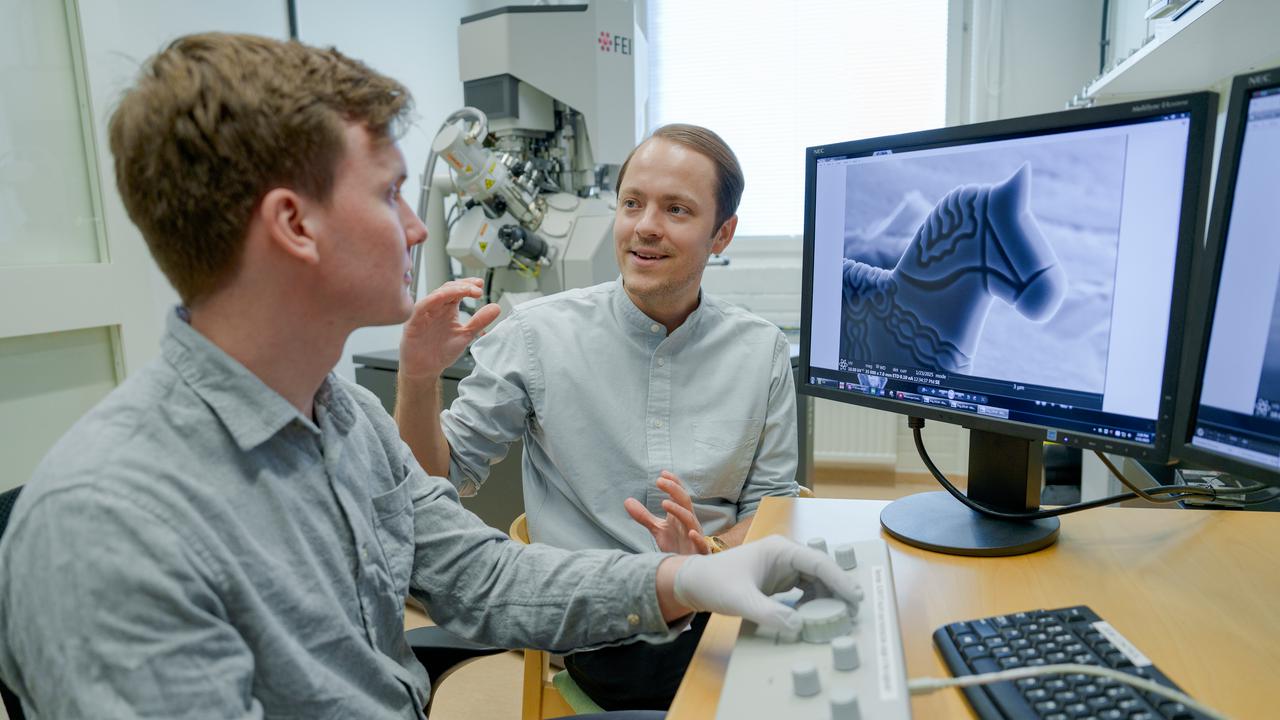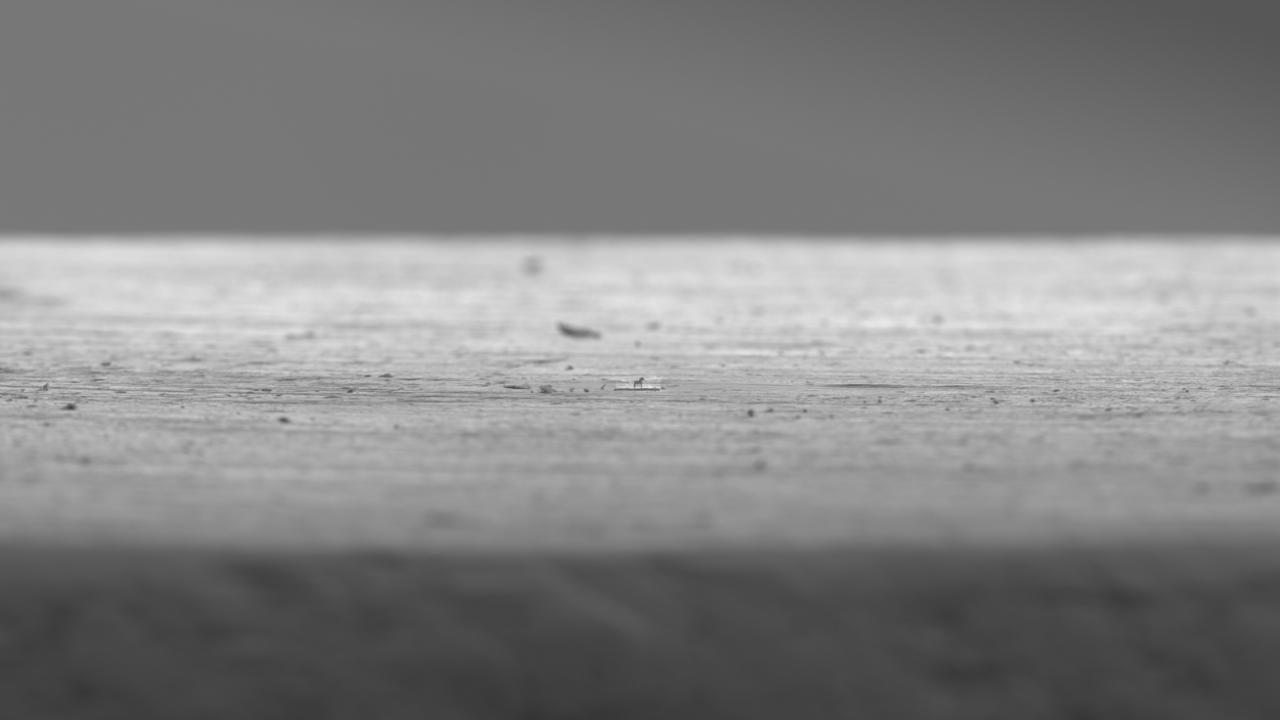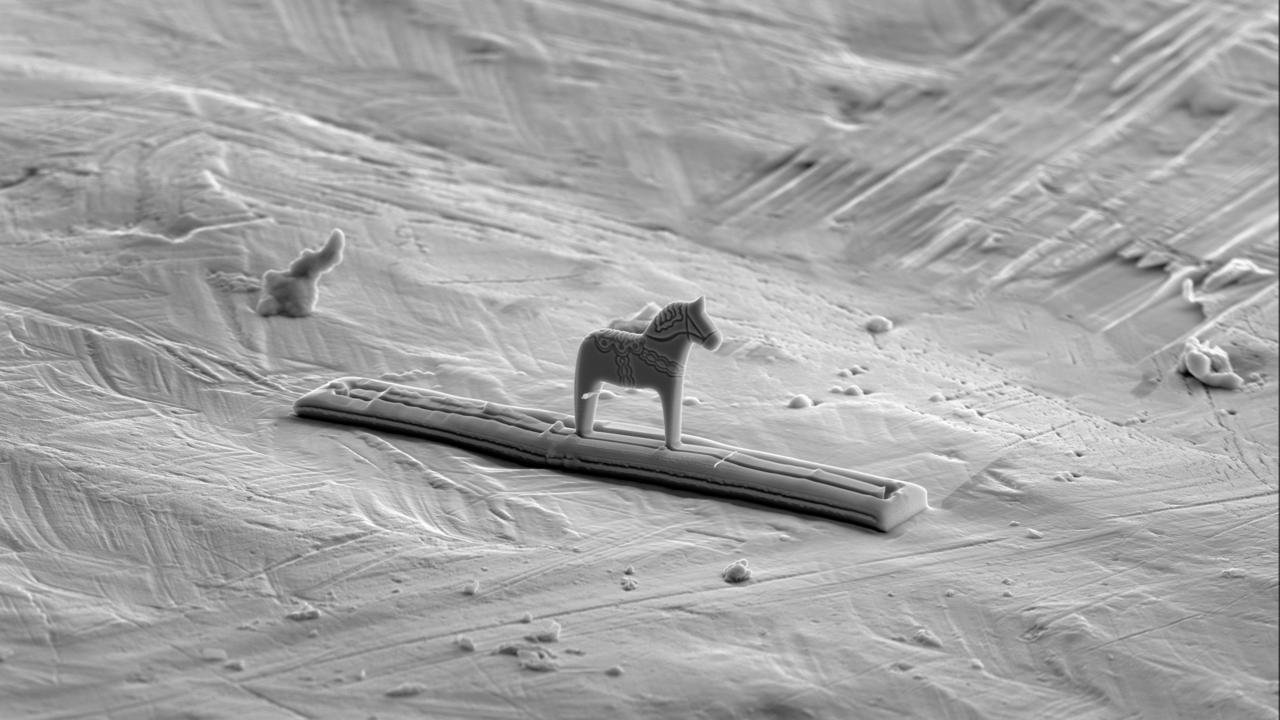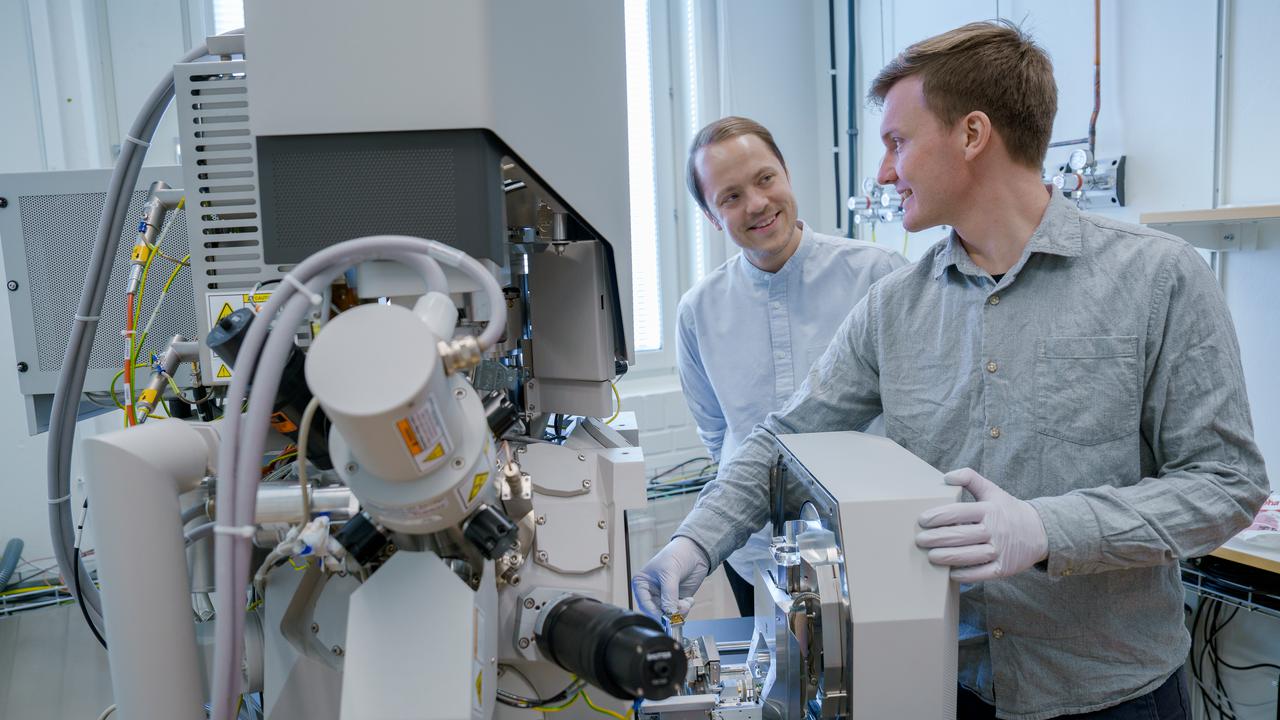For more information, please contact:
Erik Olof Wiklund, artist and graduating master's student at the Academy of Fine Arts, Umeå University.
Email: info@erikolofwiklund.com
Phone: (+46) 70 312 62 23
NEWS The artist behind one of Sweden's largest gingerbread houses, Erik Olof Wiklund, has together with Nils Hauff at Umeå Centre for Electron Microscopy, UCEM, created the world’s smallest Dala horse. As small as a red blood cell, the microscopic horse is invisible to the naked eye. The project is a unique collaboration of artistic creativity and advanced nanotechnology, part of the Umeå Academy of Fine Arts’ master’s exhibition at Bildmuseet this summer.

Erik Olof WikLund, artist and master student at the Academy of Fine Arts, Umeå University and Nils Hauff, staff scientist, has together carved our the worlds smallest Dala horse at Umeå Centre for Electron Microscopy, Umeå University and SciLifeLab.
ImageMattias PetterssonThe inspiration for the microscopic Dala horse – Dalahäst in Swedish – came several years ago when Erik Olof Wiklund saw the previous “world’s smallest Dala horse”, a few millimetres tall, at a museum in Dalarna. "I remember thinking it was unnecessarily large to be the world’s smallest," Wiklund recalls with a laugh.
When he began working on his master’s project this past winter at the Umeå Academy of Fine Arts, he found the idea of the world’s smallest Dalahäst in one of his notebooks. "I thought, well, I’m at a university now – surely there must be someone here who knows someone who can help," he says.
After many emails and phone calls, his idea eventually landed with Nils Hauff, staff scientist at UCEM, the electron microscopy unit at Umeå University and part of SciLifeLab. "I never imagined the help I needed would be right here in Umeå – it felt too good to be true," says Wiklund.

Can you see the microscopic sculpture? The worlds smallest Dala horse, 7 micro metres, is as small as a red blood cell, or the tenth of the width of a human hair.
Image rightsErik Olof Wiklund, Nils Hauff
"It’s not every day I get requests like this," says Nils Hauff, who normally uses electron microscopes for world-leading research on biological processes in cells and studies of materials at the nanoscale.
To create the microscopic horse, they used a focused ion beam – a tool typically used to cut away material to reveal internal structures. It works somewhat like an extremely precise laser beam, capable of removing material with remarkable accuracy.
"Instead of removing material, we were now creating something. It was an exciting challenge," says Hauff, who carved the horse from a tiny piece of platinum. “I was thinking that I need to remove everything that is not a horse,” he explains laughing.

Erik Olof WikLund and Nils Hauff
Image Mattias PetterssonOne of the biggest challenges was controlling the ion beam so the horse wouldn’t be blown away during the process. "Imagine an incredibly powerful and thin beam that can burn away material at an incredible speed. We had to work with extreme precision," says Hauff.
From idea to finished micro-sculpture, the process took several weeks. Wiklund and Hauff had to develop a shared language to communicate their vision. Together they unpacked concepts like micrometers, ion beams, and what an electron microscope actually is, forming a bridge between two vastly different fields.
"I think we both learned a lot from each other," says Wiklund.

They have used a FIB-SEM (focused ion beam-scanning electron microscope) to carve out the microscopic Dala horse from a piece of platinum.
ImageMattias PetterssonDespite its minimal size of just 7 micrometres – about 10 times thinner than a human hair – the Dala horse features intricate details and classic patterns inspired by traditional painted wooden horses.

The dala horse, gifted to the artist Erik Olof Wiklund's grandfather, which has inspired Erik Olof's artistry.
Image Erik Olof Wiklund"I was born and raised in Alfta, Hälsingland, near the border of Dalarna, and I’ve used the Dala horse as a recurring motif in my art. For this project, the pattern was inspired by a horse my grandfather received from his father as a child. I’m incredibly happy with the level of detail we achieved – the result exceeded my expectations," says Wiklund.
For him, the project is about more than advanced technology – it is also a dialogue between art and science, where collaboration with a scientist has offered new perspectives. In many ways, the tiny horse became a metaphor for Wiklund’s own artistic journey during his studies.

Erik Olof WikLund, holding the tiny Dala horse
Image Mattias Pettersson"I’ve carried my cultural heritage with me, but I’ve also had to scale it down, question it, and see it in a new light through the eyes and contexts of others. By minimizing its size, I paradoxically amplified its significance and realised that the small can be just as powerful as the large. Is it the horse’s physical form that defines it – or the story and value we assign to it?"
"When we captured the images of the horse with the microscope, I got to see how an artist thinks about aesthetics. As scientists, we often don’t think about beauty in the same way as an artist," says Hauff.
This type of collaboration is an example of how art and science can enrich one another. Umeå University has a strong tradition of interdisciplinary collaboration, and now art and science have come together to create something new. The project is part of Erik Olof Wiklund’s thesis work at the Academy of Fine Arts.
"This project shows how research infrastructure can be used in unexpected ways," says Hauff.
"And above all, how much fun it can be to let different worlds meet," adds Wiklund.



The project is part of Erik Olof Wiklund’s degree project at the Umeå Academy of Fine Arts.
Erik Olof Wiklund, artist and graduating master's student at the Academy of Fine Arts, Umeå University.
Email: info@erikolofwiklund.com
Phone: (+46) 70 312 62 23
The one-of-a-kind world’s smallest Dala horse will be on display at the Umeå Academy of Fine Arts’ master’s exhibition at Bildmuseet – one of Sweden’s leading contemporary art institutions – from May 23 to August 17, 2025. Don’t miss your chance to see the world’s smallest Dalahäst. Welcome!
Read more: https://www.umu.se/en/umea-academy-of-fine-arts/exhibitions/mfa2-infinite---proposals/

The Dala horse, or Dalahäst, is a traditional carved wooden horse originating from the Swedish province of Dalarna. Originally crafted as toys in the 17th century, they became a symbol of Swedish craftsmanship and folk art. Painted in bright colours with intricate patterns, the Dalahäst is now recognised as a national symbol of Sweden and a beloved cultural icon, representing tradition, rural heritage, and Swedish identity.